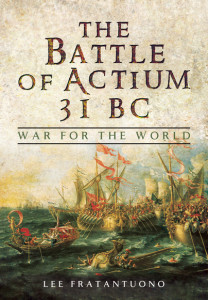Lee Fratantuono
The Battle Of Actium 31 BC
(Pen & Sword, 2016) 194 pp. £19.99
The Battle of Actium was one of the more decisive battles of ancient history. Before the battle, Rome had been in a state of internal strife that had lasted for about a century from the rising discontent that led to the election of the Gracchi and then led to their deaths, to the civil wars of Marius and Sulla, as well as the Catalline conspiracy and the wars of the first and second triumvirates. This book only gives a very short discussion of that context. Afterward, though, Rome had control of the Mediterranean Sea for centuries and had extinguished the various Hellenistic states that had sprung up all over the Eastern Mediterranean in the aftermath of the collapse of the empire of Alexander the Great. As a truly decisive battle, there was no opportunity for the combatants to learn from the course of the battle, on the one side because within a year resistance had been wiped out by the victorious Romans under Octavian and there was little fight left in Mark Anthony and Cleopatra, and on the other side because there was no one left to fight a naval battle on the Mare Nostrum for a long time to come. Yet despite the decisiveness of the battle, there is much about this battle that remains unknown.
This particular book seeks to provide the relevant source material to help explain what happened at the Battle of Actium. Its intent is not to provide the broader context of the wars of the late Roman Republic except insofar as to give some idea of what was going on for those readers who do not have a large degree of background knowledge about the history of the late Roman Republic. The book begins with a discussion of the Greek-language historical sources that deal with the Battle of Actium, with chapters about Plutarch, Appian, Dio Cassius, Strabo, and Josephus. The second part of the book examines Roman prose historical sources, including the Velleius Paterculus, some lost Roman sources, Octavian’s own memoirs, the accounts of Florus and Eutropius, and some evidence from a late source in Orosius. The third part of the book provides some accounts of Actium in verse, including a chapter on the description of the battle in the shield of Aenas, some possible references in Horace’s Epodes, Cleopatra’s Ode from Horace, an elegy of Propertius, a possible allegory in the penultimate book of Virgil’s Aeneid as a cavalry battle, and the lost epic poem Carmen de Bello: Aegyptiaco/Actiaco. The fourth part of the book consists of the author analyzing the evidence to discuss the disposition of forces in the battle, what really happened, and how the romantic legend of Cleopatra and Mark Anthony’s flight formed. The fifth and final chapter gives the aftermath of the battle, and how Mark Anthony and Cleopatra were unable to reverse the verdict of Actium in the year after the battle and how both ended up dying by suicide, and how Cleopatra’s death in particular was very convenient for Octavian in that it allowed him to avoid the stigma of having executed a woman, even a hostile one. After about 150 pages or so of written content, the rest of the book is taken up by voluminous endnotes, a bibliography for future reading, and an index.
The author gives a good reason for why this book was written when he says that “it seemed unbelievable that so major an event in military history should be so poorly understood, and that so many questions should linger about the events of that September day. Questions such as whether or not Antony and/or Cleopatra always planned an attempt at escape from entrapment, and just how great a role in the battle was played by Egypt’s most famous queen seemed surprisingly vexed (ix-x).” This is a book that should give anyone who wants to know more about the battle of Actium enough information from primary sources to come to their own conclusions about these vexing questions: How even was the battle? Why did Mark Antony’s forces resort to larger ships at the expense of vulnerability? What implications does Actium have for contemporary naval dispositions? Did Antony and Cleopatra flee only when the battle seemed lost or did their flight precipitate the defeat of Antony’s forces? Did Cleopatra participate in the discussions and meetings before the battle, and did her presence harm the morale of Antony’s forces even while providing it with ships, manpower, and money? This book addresses all of these questions and many more, including some questions readers might not have thought to ask, such as why the Roman poets refused to mention Cleopatra by name even when they are clearly talking about her, and why he victorious Arruntius of Octavian’s center got no credit nor lasting reputation at all from his own hard-fought victory in the battle, in stark contrast to Agrippa and Octavian themselves.
Concerning the author’s intended audience, this book is aimed at a very broad audience. As the author says, “It is my hope that this book will be of interest to a wide range of possible readers, including both those primarily interested in Roman military and naval history, and those with a particular love for Virgil and his contemporary poets of Augustan Rome (x).” This is a book that is positioned to succeed whether the reader is fond of the military history of Rome or whether the reader is interested in a novel and revisionist take on classic Greek and Latin literature. Either way, this short book has a lot to offer a reader on a very narrow and specific point, namely the Battle of Actium and its portrayal in ancient sources. If one is looking for a study of the Battle of Actium, this book demands a place on that bookshelf as an essential source on the battle and its historiography.
Nathan Albright
Norwich University

